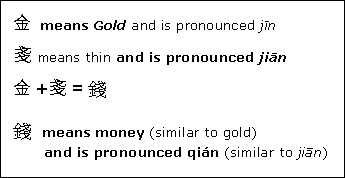





No, by "romanizing" Chinese, we mean using the letters of the Roman
alphabet (you know, "A, B, C...") to spell out the sounds of
the characters, such as bĕi, nán, dōng, and
xī to represent ,
,
,
and
. This is done
to make learning how to pronounce characters easier.
In other words, romanization is a learning tool for pronunciation, not a replacement for characters.
Such a tool is necessary because nothing in a Chinese character itself tells
exactly how to pronounce it. For instance, out of the blue, would you
know how to say ""?

A source of confusion in the West is the fact that several systems exist for spelling Chinese words with roman letters, and most people have no idea which they're seeing when they encounter one. The three most common systems are called Wade-Giles, Yale, and Pīnyīn.
The Wade-Giles system was developed in the 19th century by Sir Thomas Francis Wade, a British officer and diplomat who served in China, and was later modified by Cambridge professor Herbert Allen Giles. The Yale system was developed at Yale University in the late 1940's, originally for (according to some sources) teaching Mandarin and Cantonese Chinese to military and diplomatic personnel.
Pīnyīn, which is pronounced like peen-yeen and means literally "spell-sound," is the official system that the People's Republic of China began developing in the late 1950s to help fight the country's illiteracy problem. It is still used in Mainland China to teach elementary school students how to pronounce their native tongue.
AS IF THAT WEREN'T CONFUSING ENOUGH...As the People's Republic of China plays an increasingly important role in global affairs, Pīnyīn has emerged as the system used most in the Western world. It has been officially adopted by the International Organization for Standardization (ISO), the United Nations, and the governments of the United States and many other western nations. You'll find it used throughout the rest of this site as well.
Just the same, it will be to your advantage to make yourself familiar with all three of these romanization systems. That way, you can easily work with materials from most any romanized source.
For comparison, this table shows how Wade-Giles, Yale and Pīnyīn romanize this sentence, which means "I am going to Beijing." (And note that this chart includes tone markers, which you'll read about later.)
| System |
Romanization |
| Wade-Giles | wo3 ch`ü4 pei3 ching1. |
| Yale | wŏ chyù běi jīng. |
| Pīnyīn | wŏ qù běi jīng. |
The three systems, as you see, do have some similarities ... and some grand differences. And while we're on the topic, why not check out what the U.S. Library of Congress decided on the romanization issue.
Putting all that in context, to give you a look at how some other terms compare, take a look at these well-known Chinese names rendered in Wade-Giles, Yale, and Pīnyīn: